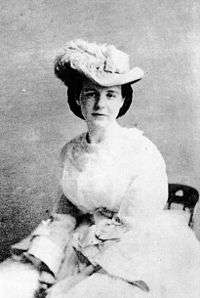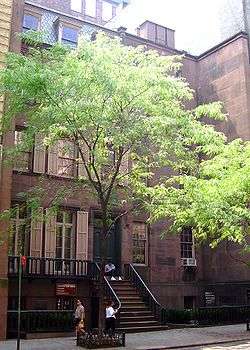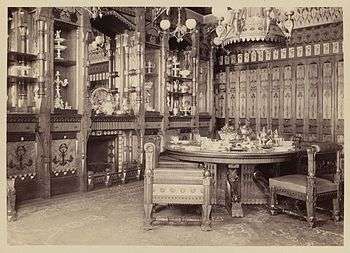Theodore Roosevelt Sr.
| Theodore Roosevelt Sr. | |
|---|---|
 | |
| Born |
September 22, 1831 New York City, New York |
| Died |
February 9, 1878 (aged 46) New York City, New York |
| Occupation | Businessman, philanthropist |
| Employer | Roosevelt and Son |
| Spouse(s) |
Martha Stewart Bulloch (m. 1853–78; his death) |
| Children | Anna, Theodore Jr., Elliott, and Corinne |
| Parent(s) |
Cornelius Van Schaack Roosevelt Margaret Barnhill |
| Relatives | See Roosevelt family |
Theodore "Thee" Roosevelt Sr. (September 22, 1831 – February 9, 1878) was an American businessman and philanthropist. He was also the father of President Theodore Roosevelt and the paternal grandfather of First Lady Eleanor Roosevelt. He was a fourth-generation Dutch New Yorker and participant in the Roosevelt family business of plate-glass importing, Roosevelt & Son.
Theodore Sr. helped found the New York City Children's Aid Society, the Metropolitan Museum of Art, the American Museum of Natural History, and the New York Children's Orthopedic Hospital. A participant in the dazzling New York society life, he was described by one historian as a man of both "good works and good times." In December 1877, he was nominated to be Collector of the Port of New York but was rejected by the U.S. Senate.
Family
Theodore Sr. was born in New York City to businessman Cornelius Van Schaak "C.V.S." Roosevelt (1794–1871) and Margaret Barnhill (1799–1861). His four elder brothers were Silas, James, Cornelius Jr., and Robert. Thee's younger brother William died at the age of one.[1]
Thee married Martha Stewart "Mittie" Bulloch (1835–1884) of Roswell, Georgia on December 22, 1853. She was the younger daughter of Major James Stephens Bulloch (1793–1849) and Martha P. "Patsy" Stewart (1799–1864). Mittie was also a sister of Civil War Confederate veteran Irvine Stephens Bulloch (1842–1898) and half-sister of Civil War Confederate veteran James Dunwoody Bulloch (1823–1901). They married at her family's historic mansion, Bulloch Hall in Roswell. Thee and Mittie had four children; Anna ("Bamie") (1855–1931), Theodore Jr. (1858–1919), Elliott (1860–1894), and Corinne (1861–1933).
Elliott was the father of First Lady Eleanor Roosevelt (1884–1962). Eleanor was the wife of Hyde Park distant cousin President Franklin D. Roosevelt (1882–1945).
His son's recollections
Of Theodore Sr., or "Thee" as he was known, his namesake son, in his autobiography described him in the following words:
My father, Theodore Roosevelt, was the best man I ever knew. He combined strength and courage with gentleness, tenderness, and great unselfishness. He would not tolerate in us children selfishness or cruelty, idleness, cowardice, or untruthfulness. As we grew older, he made us understand that the same standard of clean living was demanded the boys as for the girls; that what was wrong in a woman could not be right in a man. With great love and patience, and the most generous sympathy and consideration, he combined insistence on discipline. He never physically punished me but once, but he was the only man of whom I was ever really afraid. I do not mean that it was a wrong fear, for he was entirely just, and we children adored him. ...
I never knew anyone who got greater joy out of living than did my father, or anyone who more whole-heartedly performed every duty; and no one whom I have ever met approached his combination of enjoyment of life and performance of duty. He and my mother were given to hospitality that at that time was associated more commonly with southern than northern households. ...
My father worked hard at his business, for he died when he was forty-six, too early to have retired. He was interested in every social reform movement, and he did an immense amount of practical charitable work himself. He was a big, powerful man, with a leonine face, and his heart filled with gentleness for those who needed help or protection, and with the possibility of much wrath against a bully or an oppressor. ... [He] was greatly interested in the societies to prevent cruelty to children and cruelty to animals. On Sundays, he had a mission class."[2]
In a 1900 letter, Roosevelt described his father, writing:
I was fortunate enough in having a father whom I have always been able to regard as an ideal man. It sounds a little like cant to say what I am going to say, but he did combine the strength and courage and will and energy of the strongest man with the tenderness, cleanness, and purity of a woman. I was a sickly and timid boy. He not only took great and untiring care of me—some of my earliest remembrances are of nights when he would walk up and down with me for an hour at a time in his arms when I was a wretched mite suffering acutely with asthma—but he also most wisely refused to coddle me, and made me feel that I must force myself to hold my own with other boys and prepare to do the rough work of the world. I cannot say that he ever put it into words, but he certainly gave me the feeling that I was always to be both decent and manly, and that if I were manly nobody would laugh at my being decent. In all my childhood he never laid hand on me but once, but I always knew perfectly well that in case it became necessary he would not have the slightest hesitancy in doing so again, and alike from my love and respect, and in a certain sense, my fear of him, I would have hated and dreaded beyond measure to have him know that I had been guilty of a lie, or of cruelty, or of bullying, or of uncleanness or cowardice. Gradually I grew to have the feeling on my account, and not merely on his."[3]
To combat his poor physical condition, his father encouraged the young Roosevelt to take up exercise. To deal with bullies, Roosevelt started boxing lessons.[4] Two trips abroad had a permanent impact: family tours of Europe in 1869 and 1870, and of the Middle East 1872 to 1873.
Support for the Union during the Civil War

Theodore Sr. was an active supporter of the Union during the Civil War. He was one of the Charter Members of the Union League Club, which was founded to promote the Northern cause. He has not been listed as such, probably because his wife was a loyal supporter of the Confederacy, and her brothers Irvine Stephens Bulloch and James Dunwoody Bulloch were fighting for the Confederate Army. It was perhaps because of her active support of the Confederate Army that Theodore Sr. hired a replacement to fulfill his draft obligation in the Army of the Potomac. During the war, he and two friends, William Earl Dodge Jr. and Theodore B. Bronson, drew up an Allotment System, which amounted to a soldier's payroll deduction program to support families back home. He then went to Washington, lobbied for, and won acceptance of this system, with the help of Abraham Lincoln himself. Theodore Sr. and Mr. Dodge were appointed Allotment Commissioners from NY State. At their expense, the two men toured all NY divisions of the Army of the Potomac in the field to explain this program and sign interested men up, with a significant degree of success. In 1864, the Union League Club recruited money and food to send Thanksgiving Dinner to the entire Army of the Potomac. Theodore Sr. served as Treasurer for this generous outpouring of support for the troops. The elder Roosevelt meticulously listed every donation received in a Union League Report dated December 1864.
Seeming contradiction of his avoidance of military service
Despite all these works by Thee for his country and the northern soldiers, one aspect of his life always remained a source of regret for his son and future president, Theodore (TR). Thee never personally served in the military. Instead, Thee paid for another soldier to take his place. This was perfectly legal, but something was the one seemingly contradictory aspect of his character that Theodore Jr. could never really accept. It would influence his son's decision to seek actively a combat role in the Spanish–American War with a volunteer cavalry regiment, that the press would call the "Rough Riders."
This lack of military service needs to be understood within its context. Thee was married to a true southern belle, Martha Stewart "Mittie" Bulloch a beautiful and wonderfully gay woman at her best of times, not unlike Margaret Mitchell's fictional Scarlett O'Hara of whom Mittie was probably one real-life source; Mitchell had interviewed Mittie's childhood friend and bridesmaid, Evelyn King, for a story in the Atlanta Journal newspaper in the early 1930s. In that interview, Martha's remarkable beauty, charm, and fun-loving nature were laid out in detail. Mittie was terrified for her brothers, Irvine and James, who were both involved in the Civil War on the Confederate side. James was a Confederate agent while Irvine was the youngest officer on the CSS Alabama, supposedly firing the last gun before the ship sank in battle off the coast of France. These emotional crises were mitigated somewhat by the incredible maturity and management abilities of Thee and Mittie's elder daughter, Bamie, who often stepped into a leadership role, especially when Thee was often out of town in Washington, visiting Lincoln and lobbying Congress for programs to support the northern troops in the field and their families back home. Nevertheless, had Thee left his delicate home situation to fight literally against his wife's brothers and her southern kinfolk, the emotional consequences to his family would probably have been catastrophic.
Orthopedic Hospital

Roosevelt founded the New York Orthopedic Hospital. His younger daughter Corinne wrote this account of its origins: Bamie, was born with a curved spine, and Roosevelt found a young doctor, Charles Fayette Taylor, who had developed groundbreaking methods of treating physical defects in children, including braces and other equipment, Roosevelt organized what appeared to be a social party for the upper crust of New York City. When the would-be revelers arrived, however, what they saw to their great surprise, were small children in new braces specially constructed for them. Moved to tears by the sight, one of the wealthiest socialites, Charlotte Augusta Gibbes (wife of financier/philanthropist John Jacob Astor III) said, "Theodore, you are right; these children must be restored and made into active citizens again, and I for one will help you in your work." That same day enough money was collected to start the hospital. Friends of Roosevelt used to see him coming and note the look in his eyes only to say to him, "How much is it, this time, Theodore?"
Other philanthropic interests
He contributed large sums to the Newsboys' Lodging-house and the Young Men's Christian Association. He organized the Bureau of United Charities and was a commissioner of the New York State Board of Charities. He was a director of the Metropolitan Museum of Art and of the American Museum of Natural History.[6]
Death
He died at the age of 46 from a gastrointestinal tumor that caused him great pain for months and prevented him from eating. Initially, he kept the extent of his illness from his elder son, who was away attending Harvard. In the end, however, 19-year-old Theodore Jr. was informed and immediately took a train from Cambridge to New York, where he missed his father's death by a few hours. Biographer H. W. Brands argued that the timing of his death contributed heavily to the younger Theodore's psychology, since the future president knew his father fully while growing up, but missed knowing his father man-to-man, and therefore absorbed a view of his father entirely in his role as a parent, untempered by much realization of his human imperfection.[7]
Residences
The year after their 1853 marriage, Mr. & Mrs. Roosevelt moved to a Manhattan city house at 28 East 20th Street. All of their children were born there. The house was demolished in 1916. Following President Roosevelt's death in 1919, the vacant lot was purchased, and the house was re-created as the Theodore Roosevelt Birthplace National Historic Site.
In 1872, the Roosevelt family moved to a city house at 6 West 57th Street, where Theodore Sr. died in 1878.
 Theodore Roosevelt Birthplace National Historic Site.
Theodore Roosevelt Birthplace National Historic Site. Dining room of 6 West 57th Street.
Dining room of 6 West 57th Street.
Notes
- ↑ "POTTS FAMILY SHORT STORY". heritech.com. Retrieved 22 October 2013.
- ↑ Autobiography from the Bartleby Web site
- ↑ Bishop, Joseph Bucklin (1920) "Theodore Roosevelt and His Time Shown in His Own Letters - Book I, p. 2
- ↑ Thayer, William Roscoe (1919). Theodore Roosevelt: An Intimate Biography, Chapter I, p. 20. Bartleby.com.
- ↑ Union Square Park, from NYC Parks.
- ↑
 Isa Carrington Cabell (1900). "Roosevelt, Nicholas I.". In Wilson, James Grant; Fiske, John. Appletons' Cyclopædia of American Biography. New York: D. Appleton.
Isa Carrington Cabell (1900). "Roosevelt, Nicholas I.". In Wilson, James Grant; Fiske, John. Appletons' Cyclopædia of American Biography. New York: D. Appleton. - ↑ Brands, 1997, p. 80.
References
- Primary sources
- Roosevelt, Theodore. An Autobiography. (1913)
- Secondary sources
- Beale, Howard K. Theodore Roosevelt and the Rise of America to World Power (1956).
- Brands, H. W. T.R.: The last Romantic. 1997 Basic Books ISBN 0-465-06959-2. See page 80 for the death of TR Sr.
- Brands, H. W. Theodore Roosevelt (2001)
- Dalton, Kathleen. Theodore Roosevelt: A Strenuous Life. (2002)
- Harbaugh, William Henry. The Life and Times of Theodore Roosevelt. (1963)
- McCullough, David. Mornings on Horseback, The Story of an Extraordinary Family, a Vanished Way of Life, and the Unique Child Who Became Theodore Roosevelt (2001)
- Morris, Edmund The Rise of Theodore Roosevelt (1979)
- Morris, Edmund Theodore Rex. (2001)
- Mowry, George. The era of Theodore Roosevelt and the birth of modern America, 1900-1912. (1954)
- Renehan, Edward J. The Lion's Pride: Theodore Roosevelt and His Family in Peace and War (1998)